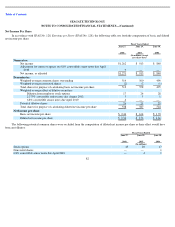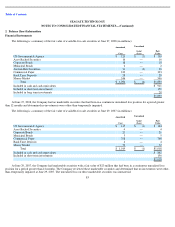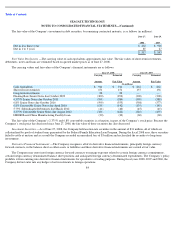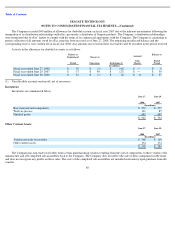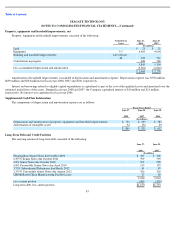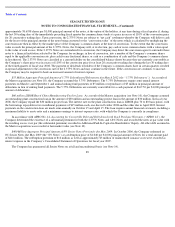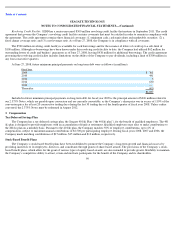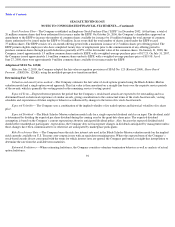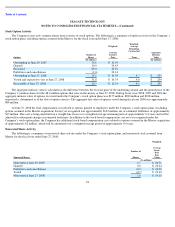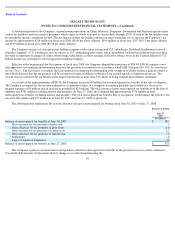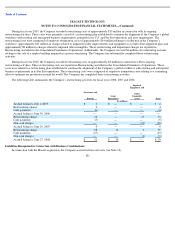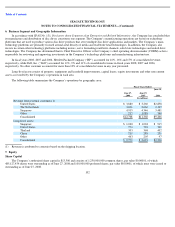Seagate 2007 Annual Report Download - page 93
Download and view the complete annual report
Please find page 93 of the 2007 Seagate annual report below. You can navigate through the pages in the report by either clicking on the pages listed below, or by using the keyword search tool below to find specific information within the annual report.
Table of Contents
SEAGATE TECHNOLOGY
NOTES TO CONSOLIDATED FINANCIAL STATEMENTS
—
(
Continued)
Stock Purchase Plan— The Company established an Employee Stock Purchase Plan (“ESPP”) in December 2002. At that time, a total of
20 million common shares had been authorized for issuance under the ESPP. On October 26, 2006, the Company’s shareholders approved an
amendment to the ESPP to increase the number of common shares available for issuance by 10 million bringing the total amount of common
shares authorized to be issued under the ESPP to 30 million. In no event shall the total number of shares issued under the ESPP exceed
75 million shares. The ESPP consists of a six-month offering period with a maximum issuance of 2.5 million shares per offering period. The
ESPP permits eligible employees who have completed twenty days of employment prior to the commencement of any offering period to
purchase common shares through payroll deductions generally at 85% of the fair market value of the common shares. On January 31, 2008, the
Company issued approximately 1.9 million common shares under its ESPP, with a weighted-
average purchase price of $17.23. On July 31, 2007,
the Company issued approximately 1.6 million common shares under its ESPP, with a weighted-average purchase price of $19.98. As of
June 27, 2008, there were approximately 9 million common shares available for issuance under the ESPP.
Adoption of SFAS No. 123(R)
Effective July 2, 2005, the Company adopted the fair value recognition provisions of SFAS No. 123 (Revised 2004), Share-Based
Payment
, (SFAS No. 123(R)), using the modified-prospective-transition method.
Determining Fair Value
Valuation and amortization method —The Company estimates the fair value of stock options granted using the Black-Scholes-Merton
valuation model and a single option award approach. This fair value is then amortized on a straight-line basis over the requisite service periods
of the awards, which is generally the vesting period or the remaining service (vesting) period.
Expected Term —Expected term represents the period that the Company’s stock-based awards are expected to be outstanding and was
determined based on historical experience of similar awards, giving consideration to the contractual terms of the stock-based awards, vesting
schedules and expectations of future employee behavior as influenced by changes to the terms of its stock-based awards.
Expected Volatility— The Company uses a combination of the implied volatility of its traded options and historical volatility of its share
price.
Expected Dividend —The Black-Scholes-
Merton valuation model calls for a single expected dividend yield as an input. The dividend yield
is determined by dividing the expected per share dividend during the coming year by the grant date share price. The expected dividend
assumption is based on the Company’s current expectations about its anticipated dividend policy. Also, because the expected dividend yield
should reflect marketplace participants’
expectations, the Company does not incorporate changes in dividends anticipated by management unless
those changes have been communicated to or otherwise are anticipated by marketplace participants.
Risk-Free Interest Rate —The Company bases the risk-free interest rate used in the Black-Scholes-Merton valuation model on the implied
yield currently available on U.S. Treasury zero
-coupon issues with an equivalent remaining term. Where the expected term of the Company’s
stock-based awards do not correspond with the terms for which interest rates are quoted, the Company performed a straight-line interpolation to
determine the rate from the available term maturities.
Estimated Forfeitures —When estimating forfeitures, the Company considers voluntary termination behavior as well as analysis of actual
option forfeitures.
92


